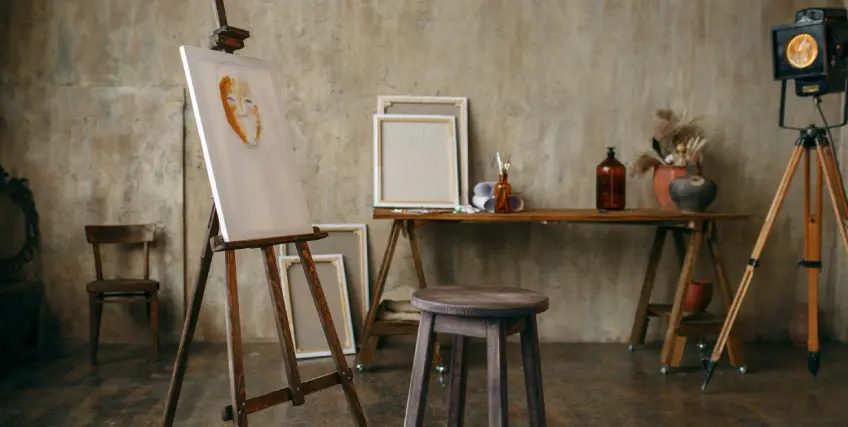5 Popular Business Loans Every Art Studio Owner Should Know About
Aug 14, 2025 | Last Updated on: Aug 18, 2025

Art fuels emotion. But running an art studio? It demands more than just creativity and passion. Running a stable art studio requires steady cash flow, financial discipline, and a bit of business savvy.
No matter if you’re renting your first art studio space or launching a new business in this creative sector, unexpected costs always pop up. You might need to cover rent, utility bills, buy high-quality supplies, or even hire part-time help or staff. But how to do this? To tackle all these unexpected expenses, smart business funding can help.
Small business loans for artists help keep the studio open and thriving, especially during slower months. Let’s see in this guide the five popular financing options that every art studio owner in the U.S. should consider. We’ll also discuss the benefits of small business loans for artists and when is the right time to consider it.
Why Art Studios in the U.S. May Need Small Business Loans
Running an art studio involves painting and creativity, but it also requires renting real estate, buying new equipment, or maintaining utilities. On top of that, other expenses like insurance, marketing through social media, and paying staff can typically stretch your monthly budget.
Even minor fluctuations in cash flow can disrupt operations. You might find yourself delaying orders, missing growth opportunities, or losing clients. This is why may art business owners across the U.S. turn to financing options and small business loans for artists to maintain growth and stability.
Additionally, managing day-to-day expenses and long-term projects require consistent financial planning. Therefore, when income dips or upfront costs surge, having access to business funding can be the difference between thriving and barely surviving.
Here’s why business loans for artists are essential:
- Studio setup or expansion: Leasing studio space in a creative district or upgrading interiors for customer appeal require small business loans for artists.
- Buying art materials and new equipment: Artists loans for small businesses can help buy art materials like quality paint, lighting, printers, or even software.
- Seasonal slowdown: During off-months, income may drop. Hence, a loan program can help bridge the gap during slow seasons.
- Workshops, exhibits, or fellowships: Small business loans for artists can help host events like workshops and exhibitions and investment in materials, marketing, and staff.
- Creative product launches or limited-time campaigns: Launching new art lines or seasonal collections may need business funding for packaging, promotions, or temporary staff support.
5 Popular Small Business Loans for Artists
Here are the different types of loans for individual artists and art studio entrepreneurs across the U.S. that can be used for various business needs.
SBA Loans
SBA loans are one of the most popular business loans, offered by the U.S. Small Business Administration. This loan program is backed by the federal government and is designed to provide financial support to small business owners. These loans often come with lower interest rates and longer repayment terms for qualified applicants. However, to qualify for SBA loans for artists, borrowers need to have a solid business plan and a good credit score.
Artists and art studio owners can use SBA loans for funding large-scale investments like purchasing real estate or addressing long-term financial needs. Moreover, these small business loans for artists can be used to rent or upgrade studio space, purchase high-quality art equipment, pay salaries, or invest in various marketing initiatives.
Business Line of Credit
A business line of credit is a flexible financing solution that offers quick access to funds when needed, up to a set credit limit. Borrowers can draw funds when they actually need it and pay interest only on the amount used.
Individual artists or art studio owners can use a line of credit to cover short-term working capital for their business. This small business loan for artists allows them to replenish supplies, pay staff, or market upcoming events without applying for a new loan each time. Additionally, these loans can be used for marketing initiatives like running social media ads.
Equipment Financing
Equipment financing allows business owners to purchase or lease the tools and machinery they need to operate their business. This small business loan is specifically designed for buying equipment. Here, the equipment itself serves as collateral, reducing the risk for the lenders.
Art studio owners can use equipment financing to cover anything from pottery wheels and kilns to large-format printers and editing software. These small business loans for artists help invest in tools that improve production quality or expand creative offerings.
Short-Term Business Loans
Short-term business loans provide a lump sum of loan amount that must be repaid over a set period of time. The repayment period for these loans often ranges from a few months to a year. However, these small business loans often come with higher interest rates due to their short duration.
These small business loans for artists can be used to cover urgent expenses such as emergency repairs, last-minute material costs, or short-term staffing for big events. While the repayment schedule is tighter, these short-term loans can help keep the studio operational and client commitments on track.
Microloans
SBA Microloans are small loan-dollar loans that are offered by nonprofit organizations or community development financial institutions (CDFIs). These business loans usually range from a few hundred dollars to $50,000. These loan programs are usually for startups or new entrepreneurs and often come with mentorship, educational resources, and support services.
For individual artists or new studio startups, microloans can be the first step toward building credit and business confidence. These small business loans for artists are perfect for launching community art initiatives, purchasing initial inventory, or covering start-up costs like website development. Since the lenders are often mission-driven, microloans align well with creative and socially impactful businesses.
Besides these small business loans for artists, you can also explore crowdfunding platforms like Kickstarter and Indiegogo to raise upfront capital. Crowdfunding offers a way to connect directly with funders and community people who believe in your art business vision.
Benefits of Using Business Loans for Artists
There’s a common myth that loans trap borrowers. But when used responsibly, they unlock growth opportunities.
Top reasons to consider small business loans for artists:
- Improved cash flow: Keep operations steady during slow seasons or late client payments.
- More room to grow: Invest in a second studio space, a digital gallery, or even your own record label.
- More creative freedom: Focus on your work while your finances are supported.
- Better business reputation: Building a track record improves your credit history and appeals to future funders.
How to Choose the Right Loan Option
Choosing a small business loan for artists starts with understanding your business and personal goals.
Ask yourself:
- What is my exact need: equipment, working capital, or expansion?
- Do I meet eligibility requirements based on credit history?
- Can I afford the down payment and monthly repayment?
- Do I prefer a fixed loan or something flexible like a credit card or line of credit?
Don’t rush the application process. Review lender reviews. Compare interest rates. Use tools from reputable platforms. Also, look at alternatives like crowdfunding and government grants.
When Is the Right Time to Take a Business Loan?
Funding decisions require planning. Timing can determine how helpful a loan becomes. Some good signs you’re ready for seeking small business loans for artists:
- Turning away clients due to limited space or resources.
- Seeing consistent demand but lacking equipment or inventory.
- Planning a new product launch or community initiative.
- Receiving a fellowship or grant and needing supplemental funds.
The Bottom Line
Art is a business. Like any other business, it requires careful financial planning and support to thrive. Access to the right small business loans for artists can provide the stability and resources necessary to grow, innovate, and meet new challenges.
In the U.S., artists and art studio owners have a variety of financing options available, from SBA loans backed by the federal government to microloans offered through nonprofit organizations. These diverse choices mean that both startups and well-established studios can find a suitable funding source that matches their goals and circumstances.
Additionally, exploring alternatives like crowdfunding can connect you directly with supporters and funders who believe in your creative mission. Combining traditional loans with innovative financing methods often leads to a more resilient and sustainable art business.
FAQs About Small Business Loans for Artists
How does my credit score affect my chances of getting a business loan?
Credit score plays a significant role but isn’t the only factor lenders consider. A strong business plan, existing cash flow, and collateral can also impact approval for small business loans for artists. Additionally, some loan programs, like microloans or nonprofit-funded loans, may have more flexible credit requirements.
Can crowdfunding replace traditional business loans for art studios?
Crowdfunding can be a valuable source of upfront capital and community support, especially for creative projects. However, it might not always cover larger expenses like studio rent or equipment. Many art business owners use crowdfunding alongside traditional loans for a balanced funding strategy.
How can I prepare my business plan to improve loan eligibility?
A well-prepared business plan clearly outlines your goals, target market, expenses, and projected revenue. Including detailed financial statements and a repayment plan can enhance your credibility with lenders. Additionally, getting feedback from business advisors or using online templates might help refine your plan.
What are some common eligibility requirements for SBA loans?
SBA loans typically require a good credit score, proof of ability to repay, and a solid business plan. They may also have specific requirements related to the business size and type. Since eligibility varies, it’s best to consult directly with SBA lenders or check official SBA resources.
How do I decide between a line of credit and a traditional loan?
If you have ongoing or unpredictable expenses, a line of credit offers flexibility because you borrow only what you need. Traditional loans provide a lump sum with fixed repayment terms, which might suit large purchases or expansions. Hence, your choice depends on your cash flow patterns and financial goals.
Frequent searches leading to this page
Term Loans are made by Itria Ventures LLC or Cross River Bank, Member FDIC. This is not a deposit product. California residents: Itria Ventures LLC is licensed by the Department of Financial Protection and Innovation. Loans are made or arranged pursuant to California Financing Law License # 60DBO-35839




